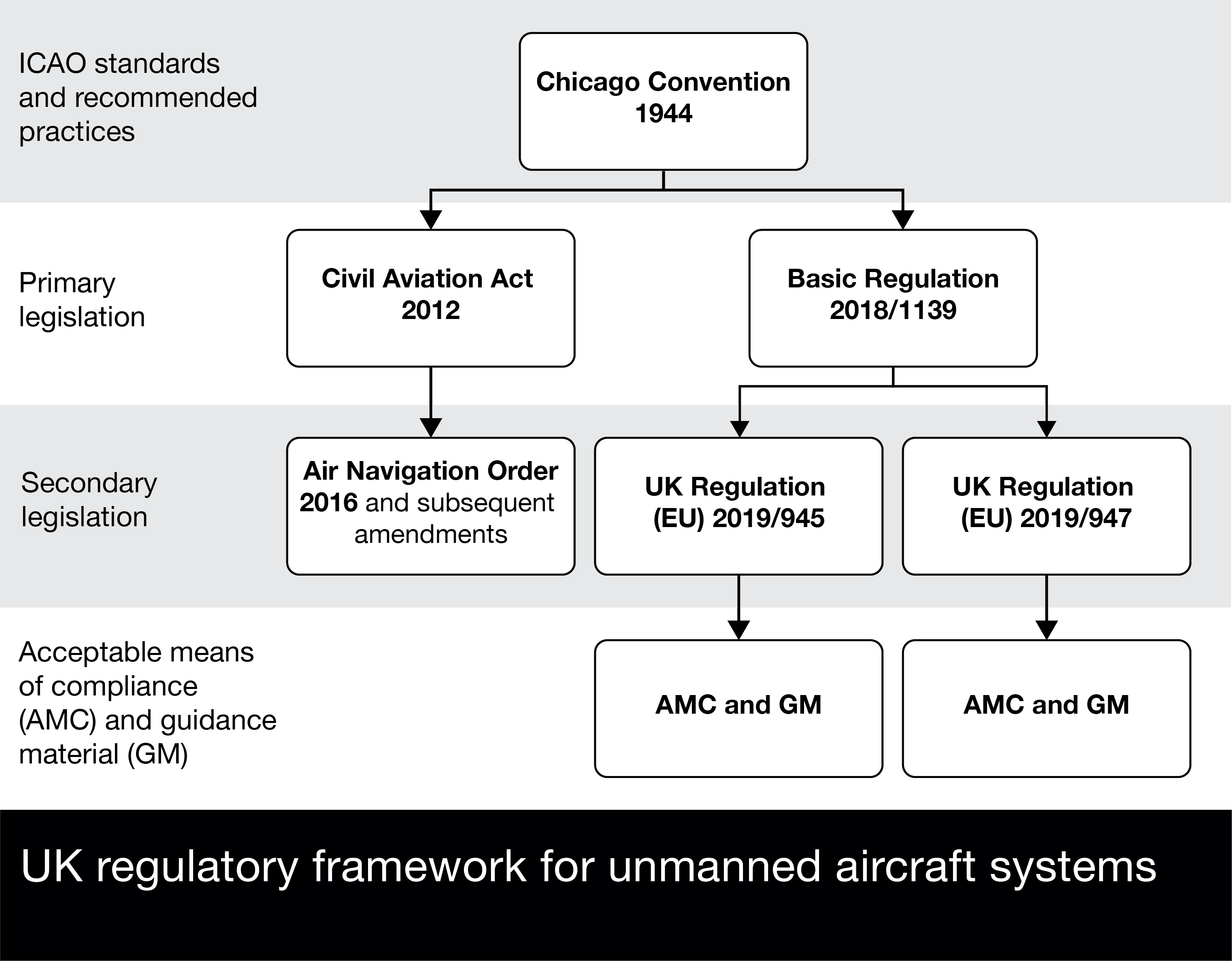Regulatory framework
The regulations for unmanned aircraft are structured in the following hierarchy.
Diagram of UK regulatory framework

1 International standards and recommended practices
International standards and recommended practices for aviation are determined by the International Civil Aviation Organization (ICAO).
The foundational standards and practices are set out in the Chicago Convention and its Annexes, signed by the UK in 1944. All ICAO signatories must adopt the standards and practices.
2 Primary legislation
In the UK, primary legislation consists of the fundamental laws that are created and passed by an Act of Parliament.
Primary legislation establishes the broad legal framework and legal obligations. It also grants the authority to implement and enforce regulations.
The UK’s regulations for unmanned aircraft are made under two separate legislative frameworks:
UK Regulation (EU) 2018/1139 (the Basic Regulation)
The Basic Regulation sets out the common rules for civil aviation within the UK.
It makes provision for implementing regulations and delegated regulations dealing with subjects such as operational safety, pilot competency, and aircraft requirements.
The core requirements for unmanned aircraft are contained within Annex IX of the Basic Regulation (opens in a new tab).
The Civil Aviation Act 2012
The Civil Aviation Act 2012 (opens in a new tab) is the primary legislation that enables regulation of all civil aviation activities, including UAS, and grants the Civil Aviation Authority (CAA) the authority to implement and enforce aviation regulation.
3 Secondary legislation
Secondary legislation translates the broad principles of primary legislation into more detailed and enforceable rules and requirements. It is created by an authorised body, such as the Sectary of State, under powers granted by primary legislation.
Secondary legislation covering UAS operations consists of two separate, but interlinked regulations:
- UK Regulation (EU) 2019/947 (opens in a new tab), commonly referred to as the UAS Implementing Regulation or UAS IR
- UK Regulation (EU) 2019/945 (opens in a new tab), commonly referred to as the UAS Delegated Regulation or UAS DR.
The main civil requirements for UK aviation are set out in the Civil Aviation (Air Navigation Order) 2016 (the ANO) (opens in a new tab).
We have provided guidance on the ANO and its effects (opens in a new tab).
4 Acceptable Means of Compliance (AMC) and Guidance Material (GM)
AMC
Acceptable Means of Compliance (AMC) are non-binding standards issued by the CAA to illustrate ways to comply with the requirements of secondary legislation, whilst also allowing alternative methods of compliance that demonstrate equivalent levels of safety or compliance.
Complying with AMC ensures you’ll meet the regulatory requirements.
GM
Guidance Material (GM) provides additional information, explanations, and recommendations to help you understand and apply secondary legislation and AMC.
GM is advisory and not legally binding. It often includes examples, definitions and descriptions to help you interpret regulations and comply with safety standards.
The CAA has published AMC and GM for the UAS Implementing Regulation (opens in a new tab).
5 Supplementary guidance
Supplementary guidance includes all other guidance, advisory circulars, and safety notices issued to provide further recommendations or clarifications.
Supplementary guidance may address specific issues or provide updates on emerging topics in aviation safety. While not legally binding, it offers insights on best practices and evolving regulatory expectations.
Other laws and regulations
UAS regulations and CAA authorisations primarily address flight safety.
Operators and Remote Pilots must not break other relevant laws and regulations, including those relating to privacy and trespass.
Privacy
If you collect images of identifiable people using your unmanned aircraft, you may be subject to the General Data Protection Regulation and the Data Protection Act 2018. This includes images that you collect inadvertently.
There is more information on protecting people’s privacy in the Drone and Model Aircraft Code (opens in a new tab).
The Information Commissioner’s Office provides more information on privacy considerations and the commercial use of drones (opens in a new tab).
Trespass
You must always have any appropriate permission before operating from a privately owned site.
You must observe the relevant trespass laws and not unwittingly commit a trespass whilst conducting a flight.
You must consider any local byelaws.
If you wish to fly over a site of special scientific interest (SSSI)(opens in a new tab), you must contact the relevant national authority for advice.

